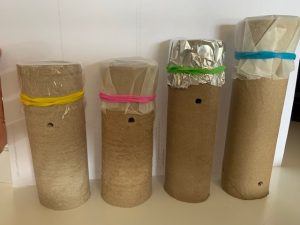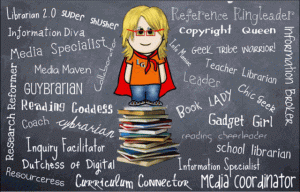Learning Log 1
For my first learning log assignment, I chose to explore topic 1, inquiry-based learning through a discrepant event. I will make a homemade kazoo to learn about the properties of sound. At the school where I am currently working as a Teacher-Librarian, the grade 4 classes will be exploring Sound in science class in the month of February. This offers me the opportunity to try out this activity to see inquiry-based learning in action. Using the discrepant event as the basis for an inquiry project, I will describe how it can lead the students to develop inquiry skills.
“Discrepant events can be a fun way to either introduce a new concept in science or test your student’s understanding. They are also powerful tools to develop inquiry skills.” (Science World, 2020)
Homemade Kazoo: Exploring the Properties of Sound
A Kazoo is a musical instrument based on the physics of how vibration makes a sound. The objective of this project is to conduct investigations to lead the students to discover that vibrating materials can make a sound.
Steps for making a Kazoo
-gather household materials suggested by Science World website
-assemble the Kazoo based on the instruction provided by Science World website
-experiment with or “tried-out” the kazoo by speaking into the opening
Wonder:
– What happens when you speak into the tube?
-Why does my voice sound different?
-How does it work?
-What does the air vent do?
-Which types of materials would work best?
-Why is the top cover vibrating?
Experiment with variable:
-speaking into kazoo softly and with force
-speaking into kazoo while blocking the air vent
-covering the top of the kazoo with different materials like tin foil and plastic wrap
-changing the location of the air vent
-changing the length of the tube
Observations and Conclusions
The location of the air vent and the length of the tube of the kazoo did not change the production of vibrations and sound. The type of material used to cover the top of the kazoo (the resonator) affected the ability to create vibrations that were audible. For example, the wax paper and the tin foil top covers allowed audible sound vibrations whereas the plastic wrap did not. I discovered that the top cover needs to be made of a firmer material that does not expand. Covering the air vent in the tube prevented the production of vibrations and sound. To produce vibrations from a kazoo, the air pushed into the tube must have a location to exit the tube. The sound of my voice and air causes the wax paper of tin foil to vibrate inside the kazoo. The rest of the air exits through the air vent and the wax paper or tin foil acts as a resonator.

How is this activity inquiry-based learning and where does the Library Learning Commons fit in?
Making observations of discrepant events can spark curiosity, generate questions, encourage planning, allow students to experiment with variables, and promote communication of results. These are all inquiry-based learning skills. Through the creation of a homemade Kazoo instrument, the students will learn how to observe, make predictions, ask questions, plan, investigate, discover, reflect, and share their findings. The following diagram highlights the various steps of the inquiry process. To clarify, I will relate the Kazoo sound project to each section of the inquiry cycle.

Image by ScienceWorld.ca
Observe and Explore
This is where I believe the library Learning Commons fits into the inquiry process. The library learning commons provide access to many different types of resources that the student can explore to learn about the properties of sound. The teacher-librarian can offer her expertise in providing articles, storybooks, picture books, and videos about sound. The students will have access to the Internet where they can explore Science websites. In my current school division, students and teachers have access to World Book Online. This encyclopedia/database offers information, videos, games, puzzles, and suggestions for science experiments about sound. I imagine the teacher and the teacher-librarian working together to create learning centers where students can examine and compare various instruments, play sound-related games such as sound BINGO, listen to a story about sound and go on a scavenger hunt to find the sounds in the school environment.
Ask Questions/Select Questions
Once the students have some background information, the teacher can prompt the students to share their questions about sound. The teacher=librarian can show the student the kazoo and ask them what they already know about the instrument. This can prompt a series of questions about how the kazoo works. I envision the teacher and teacher-librarian adding questions to the chart paper. From here students can individually select a question or the class can decide as a group which of the questions they want to be answered. Some examples may be:
- What happens when you hum into the tube?
- Why does your voice sound different?
- Why does the loudness of your voice change? (Science World, 2020)
Plan an Investigation
As a class, with guidance from the teacher, the students will come up with a plan of how to proceed to create the kazoo. They can make a materials list and the teacher can prompt the students to discover what changes can be made to the kazoo (variables).
Experiment
For this step, the students will create the kazoo. At this point, it is very essential in my opinion to give the students ample time to build, re-build and experiment will all the variables. It is through experimentation that the student will make discoveries and continue to ask more questions.
Reflect on what Happened and Share
As a class, the students can reflect on their experiments by creating an experiment log. They can then share their observations, discuss what worked and how the variable affected the kazoo. This is where the students will help each other to think more broadly about sound and its properties. Students can share which variables they chose and the conclusions they came to.
More Questions
Experimenting with variable, reflecting on their efforts, and sharing their conclusions can lead to more questions. Exploring sound further will allow the students to gain a deeper knowledge of the properties of sound and how it relates to the environment that surrounds us.
 image by Pixabay
image by Pixabay
Personal Learning Objectives
I am very interested in developing a bank of resources for inquiry-based learning. Ideally, I would like to have a bank of ideas for projects that would include templates, resources, and how-to instructions for language, science, and social studies. The ideas must be meaningful and authentic inquiry-based learning projects for students in grades K-8. I am also interested in learning how to appropriately guide the students in creating meaningful questions. What are the strategies that I should be using to lead the students in creating open-ended questions that are meaningful to our world? Lastly, I would like to learn about the various types and models of inquiry learning and how to implement them in grade k-8 classrooms.
Discrepant Events and Inquiry-Based Learning.” Science World, 8 Dec. 2020, www.scienceworld.ca/stories/discrepant-events-and-inquiry-based-learning/.
“Homemade Kazoo.” Science World, 17 June 2020, www.scienceworld.ca/resource/homemade-kazoo/.
Youtube video: https://youtu.be/JofXJWsCWtE

I am so glad that you are continuing to use your blog as a place to share and showcase your learning. It will become a portfolio of your work for the program! I will leave specific feedback for your assignments for LLED in Canvas.